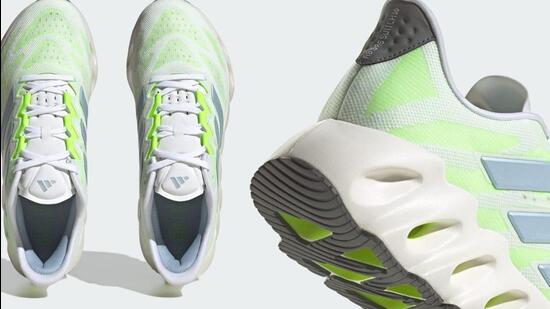It is not often running shoes, despite significant leap forward in the technology being used, get your attention almost immediately. Adidas’ latest pair, the Switch FWD does. The reason is simple – how the midsole has been constructed, outside and inside. This is serious evolution considering the Switch FWD is an extension, as the name suggests, an extension of Adidas’ FWD range that also includes the flagship 4DFWD sneakers.
The Adidas Switch FWD costs ₹13,999 and you have the choice of as many as six colourways, for men and women’s ranges.
The legacy it adds to, includes Adidas’ third generation 4DFWD shoes (around ₹21,999) and the 4DFWD Ultra (around ₹22,999).
The Switch FWD’s big idea, which is immediately available for everyone to see, is to create voids in the outsole that compress as the wearer runs and then provide the spring forward motion. Therefore, those symmetric gaps you see, when looking at the Adidas Switch FWD side on. Mind you, these gaps run all the way down to the outsole. While it may look like it, if you’ve analysed the outsole of your Switch FWD shoe, but you aren’t standing on stilts. Your mind is playing tricks.
The midsole itself is the EVA, or Ethylene-vinyl acetate foam. Integrated alongside is a TPU, or Thermoplastic Polyurethane plate (the more expensive sneakers now have carbon fibre plates), for energy transition.
Also Read:Up to speed: The anatomy of a modern-day running shoe
As you wear the Adidas Switch FWD, only a visual memory of the voids in the midsole linger in your mind. Slide the foot in, and this feels as comfortable or planted as any other running shoe worthy of being called that. Again, you don’t need to wear this any differently, change your running or jogging style or be circumspect while making direction changes. You don’t feel these physical gaps, in a disconcerting sense.
Clearly, less is more.
The way you do notice they’re there is, as the foot transitions while running. There is a tad lesser energy you need to generate, with a certain springy push quite apparent. That’s the extra downward pressure the EVA foam can take because of these physical gaps, before pushing back as a reaction. Run on a harder surface first to get a fair idea of what it feels like, before making the switch to a softer mud track, if that’s what you prefer.
Adidas has used Continental, the popular automotive tire manufacturer’s expertise, for the outsole. That means, the rubber compound, and the structuring is done by Continental. It takes me back many years ago, when I had an Adidas running shoe that also had a Continental outsole. This feature had gone remarkably rare, since then. This partnership is good news, if you’re circumspect about the longevity of this radical outsole tech.
The Adidas Switch FWD sits your feet slightly higher than usual, at 44.8mm and 34.8mm, back to front. The midsole drop is only 10mm though – that’s the height of the heel dropping towards the height of the forefoot. Not the lightest shoe though, at around 335 grams, which is in the ballpark of the Asics Gel-Kayano 30 (303 grams; around ₹15,999).
As for the upper, it is a fairly breathable mesh that still sits quite snugly around the foot. The inner, in case you prefer to run without socks, is a luxurious, smooth texture. The toe box is wide, and there’s enough height for the forefoot too. That said, lacing mechanism is quite conventional. I’d have preferred a slightly wider placement nearer to the tongue, for additional help in keeping the feet securely locked in.
On the upper, you’ll notice an integration of lines of fibre. Adidas calls them mesh windows. But the idea of a mesh upper is, almost the entire area should be open for ventilation. These borders for the windows may actually take away from that.
It didn’t need to be an expensive flagship running shoe, to be the test-bed for an outsole design and implementation as unique and radical as this. We must note that the idea has come together rather well with the Adidas Switch FWD.
A midsole and outsole full of voids, clearly works. There may be some trepidation if you encounter a slightly rocky (or one with pebbles/stones littered carelessly) path, because that’s when those gaps my get in the way.
Yet, this running shoe will, depending on how you utilise its strengths, be faster than some of the more expensive albeit conventional alternatives. That too, with technology that uses some of the most common mid-sole foam materials, albeit in a way and composition, that changes the very dynamic of how they work. The Adidas Switch FWD simply adds more to your daily runs. More than you’d have expected.
